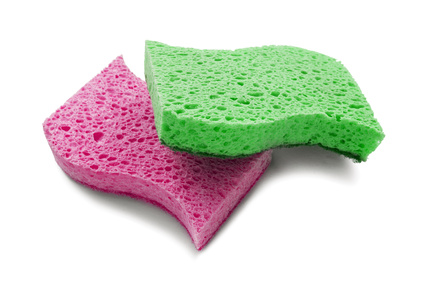 We all know that handwashing is the best thing we can do to help prevent foodborne illness, but what about all of the other surfaces in the kitchen? Towels, dish cloths, and sponges that are not clean can quickly transfer dirt and germs throughout your kitchen!
We all know that handwashing is the best thing we can do to help prevent foodborne illness, but what about all of the other surfaces in the kitchen? Towels, dish cloths, and sponges that are not clean can quickly transfer dirt and germs throughout your kitchen!
A survey done by the Academy of Nutrition and Dietetics and ConAgra Foods Foundation found that over 20 percent of Americans will use sponges until they are smelly or visibly dirty! Additionally, nearly 40% keep their sponges for 3-4 weeks or until they fall apart.
To keep these items clean, follow the tips below!
Dish Towels & Cloths:
- After washing, use disposable paper towels to dry your hands. Communal towels can be a haven for germs.
- Wash in the washing machine with HOT water and dry completely on the HIGH setting.
- Try using different colored towels for different tasks – red for drying dishes, yellow for wiping counters.
Sponges:
- Pay attention to what the sponge was used for last. If it was a germy job, be sure the sponge is cleaned BEFORE using it again. A quick rinse with water is not enough!
- Sponges can be washed in the washing machine in HOT water or on the top shelf of your dishwasher.
- Use the microwave to sanitize sponges. Wet the sponge thoroughly and microwave it on high for 2 minutes. The USDA reports that this method kills over 99% of bacteria. (Microwaving a dry or damp sponge is a fire hazard)
Reusable Grocery Totes:
These bags are good for more than groceries and it seems that everyone is giving them out – but could they be making your family sick?
- Place raw meat, poultry and fish in individual plastic bags before putting them in your reusable bags.
- To avoid cross contamination, use separate bags for raw meats and ready to eat foods.
- Clean counters, tables and other surfaces where you sit the totes.
- Wash bags and the rigid bottom inserts often in HOT water (washing machine or by hand).
- Store bags in a clean and dry location – this may not be in your vehicle trunk.
Author: Kate Shumaker , Extension Educator, Family and Consumer Sciences, Ohio State University Extension.
Reviewed by: Linnette Goard, Field Specialist, Food Safety, Selection and Management, Family and Consumer Sciences, Ohio State University Extension.
Sources:
Academy of Nutrition and Dietetics, Home Food Safety. Reusable Grocery Tote Safety. http://homefoodsafety.org/separate/reusable-grocery-tote-safety. Retrieved 8/3/14.
Academy of Nutrition and Dietetics, Home Food Safety. Surfaces and Sponges. http://homefoodsafety.org/wash/surfaces-and-sponges. Retrieved 8/3/14.
Web MD. Germs in the Kitchen. http://www.webmd.com/food-recipes/features/germs-in-kitchen?page=2. Retrieved 8/3/14.
Photo Credit: © Tarzhanova – Fotolia.com
